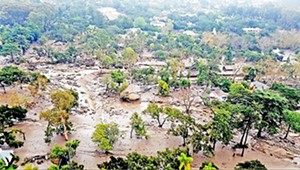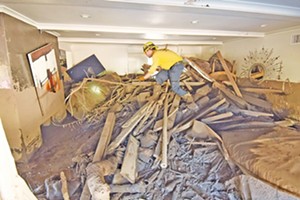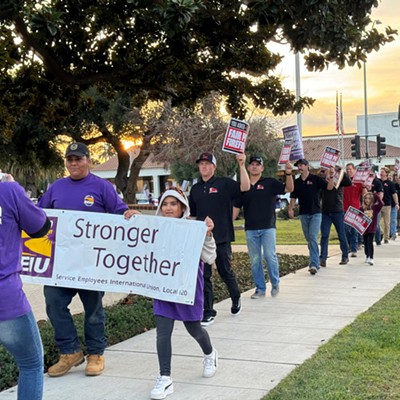For a brief stretch of time spanning December 2017 to January 2018, Santa Barbara County was synonymous with the word "disaster."
First, the Thomas Fire in December scorched hundreds of thousands of acres of federal, state, county, and private land, becoming one of the largest fires in California's recorded history. Barely a month after the blaze began, floods driven by isolated pockets of intense rain created a wall of debris, water, and mud that struck Montecito like a truck.
"We were walking through mud that was waist deep [looking for survivors]," Santa Barbara County Fire Engine Capt. Jason Sweet told the Sun. It would be weeks before he and his crew returned to their station.

The Jan. 9 debris flow incident claimed 23 lives and destroyed or damaged hundreds of homes. And even now, nearly a year later, county officials, residents, and first responders are still picking up the pieces, and trying to determine what went wrong. The latter is particularly important for emergency planners trying to prevent such deaths in the future.
On Oct. 16, Santa Barbara County's Office of Emergency Management (OEM) delivered a report to the Board of Supervisors assessing how the county's emergency operations center (EOC) responded to the disasters.
The 36-page document recommended the county shore up its evacuation plan and better disseminate it to the public through social media, text updates, and emails. It also recommended refining emergency public information and warnings in the minutes, hours, or days leading up to a disaster.
The report also called for increased collaboration between local government partners; for the county to "enhance its ability to respond to sustained EOC activation"; and to "increase the county's capability to recover from a major disaster."
Only in draft form, the current iteration is one of the longer such studies to be conducted over almost a year. According to OEM, the reports usually only take a few months.
OEM Director Robert Lewin told supervisors it was initially difficult to ascertain the damage from the Thomas Fire in the mountainous terrain above the coastal communities of Montecito, Carpinteria, and Santa Barbara before the rainstorm that caused the deadly mudflows hit.
He said that while this "after-action" report may be near completion, the county still had much work to do post disaster. For instance, a debris analysis plan is still in the works that will not be complete until 2020. Lewin attributed OEM's delay to a lack of "bandwidth."
Emergency administrators also stressed the need for an additional recovery plan to accompany the county's debris plan, which won't happen overnight because staff is already busy compiling an oil spill contingency plan after the Refugio Oil Spill in 2015.
"That's about as good as we can do, but I assure you our Public Works and the other regional players are participating in trying to handle this," Lewin added. "If we've learned anything, we've learned a whole lot about debris through this whole disaster."
One public speaker, who spoke on behalf of Montecito residents affected by the storm, was critical of the report delivered to the supervisors on Oct. 16 because it didn't address how to prevent prevent future civilian casualties.
"The deaths are undoubtedly the single most important and enduring legacy of this tragedy and yet they are mentioned in only one brief sentence and not analyzed to imagine how and why they occurred," he said.
The resident called for a root cause analysis–an investigative measure taken after a private sector industrial death.
"A death in a mine or a chemistry plant in this country at the present time is a big deal," he said. "It's certainly more than the one sentence that was in the report."
On Oct. 18, an OEM spokesperson told the Sun the purpose of the after-action report was to analyze the county's emergency operations center response to the disaster, not investigate each individual death.
The speaker also derided the report for "not being self-critical in recognizing deficiencies" such as evacuation orders and warnings, "which did not adequately define high debris flow hazard areas, nor ensure residents were informed of the imminent disaster."
Lewin chafed at this characterization. He said it's impossible to not look back and re-examine how the county handled the disaster, but "as decision makers we base our decisions on the best information we have at the time. And we believe we did that."
Lewin did not return the Sun's request for a follow-up interview by press time.

Board of Supervisors Chair Das Williams, who lives in Carpinteria, said he empathized with his Montecito neighbors and pointed to problems with getting everyone in the county on a regional alert system, as opposed to a problem-prone national one. He noted Montecito's poor flood control systems, calling them "a problem that goes back decades," and blamed part of the issue on a lack of public land.
"So much more of Montecito is in private hands than is true in a typical community," he said. "And that is a daunting but not insurmountable factor in our efforts to increase flood control."
Santa Barbara County submitted several grant applications to the Federal Emergency Management Agency since the disasters and has plans for a community, nonprofit, and federal partnership to help subsidize costs due to limited resources at the county level. Some of the work involves increasing debris basin capacity.
Williams said there were plans to build additional basins to offset future flows. "We can do something about that," he added. "We will not be able to do it before winter but we can do it." The 1st District Supervisor called the work the "most important capital project response to the disaster."
Fourth District Supervisor Peter Adam defended the county's response to the debris flows and fires. He said that there would always be a chance for something to go wrong in the areas that were hit by the fire and floods.
"It's very difficult to express the amount of risk that everybody is in that underlies any of these fires at this point," he added. "It's like a spring that's loaded up there and all you have to do is have a trigger come along and bang, it goes off."
Adam's description is a pretty spot on depiction of what the county and California can expect for the foreseeable future, according to Daniel Swain, a climate scientist at UCLA's Institute of the Environment and Sustainability. The state's and county's endless acres of poorly managed forests and heavy fuel loads could easily become the sites of more massive fires, floods, and eventual debris flows, he said.
Swain is the lead author of a paper published earlier this year detailing how fluctuations in wet and dry periods will only increase in intensity over the course of the next century. And that means more floods and more fires, he said.
"We've seen that illustrated the past couple years where we really only had a few days of rain in LA, but one of them killed 20-something people with the mudflows in Montecito," Swain told the Sun, noting that while the floods were mainly related to fires that preceded them, they were still related to those fluctuations.
"That sort of flashiness of these flows and streams and intensities of the big bursts of precipitation are characteristic of what we'll see moving forward."
Staff Writer Spencer Cole can be reached at [email protected].










